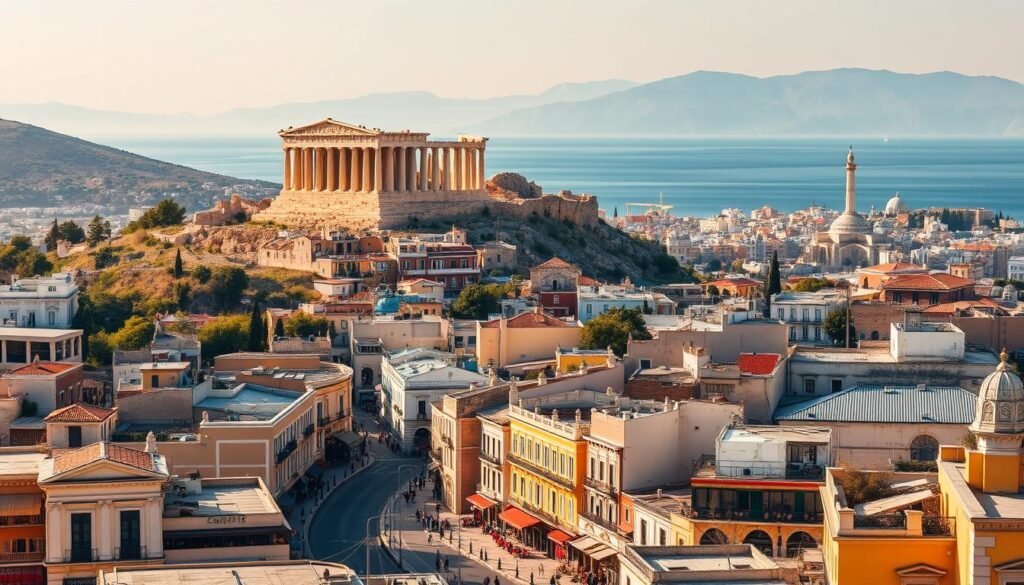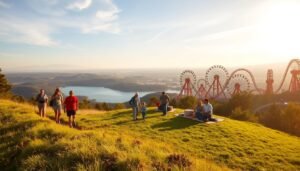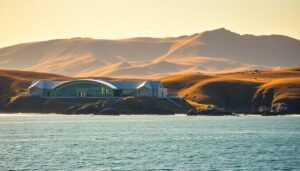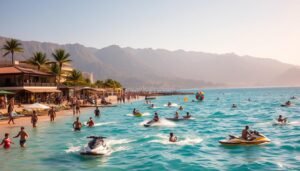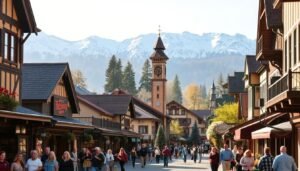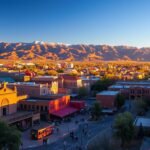Surprising fact: I found October and November here average a sunny 20–25°C, which makes off-season travel delightfully mild and far less crowded.
I wrote this guide as a first-person playbook for a relaxed trip. I sequence the big ruins so the city’s history clicks, then fold in food, neighborhoods, and rooftop views without rushing.
The Acropolis is the essential place: the Parthenon, Erechtheion, and Temple of Athena Nike anchor the story. The compact center means you can walk between Plaka and Anafiotika, pause at markets, and catch golden-hour views with ease.
I share where I saved minutes at ticket lines, where I lingered for an outdoor film, and which rooftops framed the Parthenon just right. By the end, you’ll have a clear plan for a few balanced days that trade overwhelm for easy wins.
Key Takeaways
- I organized the sequence so history and modern life connect naturally.
- Off-season weather means fewer lines and pleasant walking.
- The Acropolis and Acropolis Museum are the priority sights.
- Neighborhoods, rooftop bars, and markets add essential flavor.
- Simple ticket tips and timing saved me hours and boosted enjoyment.
How I Plan a First-Time Visit to Athens: What to Expect and How Much Time You Need
My rule is simple: cluster the big sites into logical days and leave small pockets of free time. For most first visits I aim for 2–3 days to cover essentials. Add an extra day if I want markets, street art, or a coastal detour without rushing.
The center is very walkable, so I plan walking loops that save steps and energy. I use metro Line 3 from the airport; trains run about every 30 minutes and take just over half an hour to central stops. I always buy a separate airport ticket, then decide on a 24/48/5-day pass based on how many rides I expect.
Mornings are my favorite for major attractions—cooler air and shorter lines. I build one flexible evening for sunset views or an outdoor film. In shoulder seasons like spring and fall I find milder weather and fewer crowds; summer can be hot and full of tourists.
- I map nearby highlights together (Acropolis + museum on the same day).
- I include buffer moments for cafés and viewpoints; they become trip highlights.
- For airport vs. taxi, I weigh predictability (Line 3) against door-to-door time (taxi 45–60 minutes).
| Visit Length | Main Focus | Good Seasons | Notes |
|---|---|---|---|
| 1 day | Top ruins + central walk | Spring/Fall | Fast pace; expect a lot on one day |
| 2–3 days | Acropolis, museum, neighborhoods | Spring/Fall, winter is quieter | Balanced; leaves room for evening plans |
| 4+ days | Markets, beach, relaxed exploring | Spring/Fall | Best if you like slow wandering and extras |
The Acropolis and Parthenon: Beating the Crowds, Grabbing Tickets, and Soaking Up the View
![]()
I time my Acropolis visit around light and lines so the experience feels calm and clear. The site opens at 8 a.m. and limits daily visitors, so I usually book an online ticket with a set time slot. That QR code saved me precious minutes at the gate and made my start smoother.
My timing strategy: early morning vs. late afternoon entry
I aim for an 8 a.m. entry for cooler air and softer light. Fewer crowds on the steps means better photos and easier walking. On very busy or hot days I shift to late afternoon for warm-toned views and a calmer climb.
Skip-the-line, combined tickets, and how I saved minutes at the gate
Skip-the-line options speed things up, but security checks still apply. When I plan multiple stops, I buy the Combined Ticket (valid five days) so I can visit the Ancient Agora, Hadrian’s Library, Kerameikos and more without rushing.
Don’t miss on the rock: Erechtheion, Temple of Athena Nike, and the Odeon of Herodes Atticus
I walk a simple loop: Propylaea, Parthenon, then the Erechtheion with its Caryatids. I linger at the Temple of Athena Nike for skyline photos and remember to look down at the Odeon of Herodes Atticus—still used for performances and included with entry.
I wear grippy shoes for uneven stone underfoot, carry water, and keep sunscreen handy. A short guided tour can link the ruins to the museum, or follow my compact how I visit the Acropolis for a smooth, memorable day.
Acropolis Museum: See the Story Before You Walk the Ruins
Before climbing the hill, I always start at the museum opposite the rock; it shapes everything that follows. The acropolis museum gathers original sculptures and architectural pieces so the Parthenon’s program clicks before you climb.
Top-floor Parthenon gallery and why I go first
The top floor mirrors the temple’s layout, and that layout turns friezes and metopes into a readable story. Once I see the scenes inside, the hill’s marble feels less random and more deliberate.
I also visit the ground-floor excavation. Walking over the excavated neighborhood shows everyday life beneath the modern building and ties the artifacts to living people.
- Second-floor café: a quick pause with direct Acropolis views; non-museum visitors can use it.
- Seasonal pricing: summer admission costs more than winter, and security is the main queue point even for online tickets.
- Pairing tip: I often pair the museum and the hill on the same day for clear continuity.
For families or casual visitors, labels and layout do much of the guiding. If you visit looking for plain context, you’ll find the ancient greek stories and wider history of the site and city unfold naturally.
things to do in athens: My Essential Ancient Sites Beyond the Acropolis

My next stops are compact archaeological spots that reward slow walking and a little imagination. I spread them across two days with the Combined Ticket so I don’t tire of ruins and can enjoy each site.
Ancient Agora and the Temple of Hephaestus
I head here right after the hill. The Temple of Hephaestus is one of the best-preserved Doric temples anywhere. Its clear lines make the city’s classical history feel immediate.
Roman Agora and the Tower of the Winds
The roman agora was funded by Julius Caesar and Augustus. I stroll the small square and pause at the octagonal Tower of the Winds for a closer look.You can learn more about things-to-do-in-florence-italy
Hadrian’s Library and Kerameikos
Hadrian’s Library (132 AD) shows columns and fragments that invite a quick mental reconstruction. A reference image helps if you like visual context.
Kerameikos is quieter. I take a shorter, reflective visit among funerary markers and the remaining city walls.
Olympieion and the Arch of Hadrian
The Olympieion’s columns still impress—about 15 of 104 stand. I slip outside to admire the Arch of Hadrian for free and then weave back along shaded streets.
- I space these sites over time with the Combined Ticket to avoid “archaeology fatigue.”
- I wear grippy shoes; uneven stone is common underfoot.
- When short on time, I prioritize Ancient Agora, Olympieion, and the Roman Agora’s Tower of the Winds for impact and efficiency.
| Site | Highlight | Access | Visit Length |
|---|---|---|---|
| Ancient Agora | Temple of Hephaestus, market remains | Combined Ticket | 1–2 hours |
| Roman Agora | Tower of the Winds, small forum | Combined Ticket | 30–60 minutes |
| Hadrian’s Library | Columns, mosaics, 132 AD layout | Combined Ticket | 30–45 minutes |
| Kerameikos / Olympieion | Funerary monuments; 15 standing Corinthian columns; Arch nearby | Combined Ticket / free for Arch | 45–90 minutes |
Syntagma Square and the Tomb of the Unknown Soldier: When I Watch the Changing of the Guard
![]()
Watching the Evzones at the Tomb of the Unknown Soldier became one of my favorite quick rituals in the city. The guard swaps happen hourly in front of the Greek Parliament, but Sunday at 11:00 is when the full honor guard and military band turn it into a real ceremony.You can learn more about things-to-do-in-cincinnati-ohio
Why Sundays at 11 a.m. feel extra special
I arrive just before the hour so I can find a clear spot and see the Evzones’ measured steps and pom‑pom tsarouchia shoes. I stand respectfully and avoid blocking the route; many people come specifically for the pageantry.
- I often pair this stop with a slow wander through the nearby National Garden to cool off.
- If I’m building a self-guided tour day, I anchor the morning around this time and fill nearby sights into the plan.
- After the ceremony I take a few photos of the Parliament façade, then look for shade—midday can get warm on any day.
National Garden to Panathenaic Stadium: A Green Pause and an Olympic Icon
![]()
I often slip into a quiet green pocket near Syntagma that feels like a soft reset from the city’s bustle.
The National Garden began as Queen Amalia’s private plot in 1838 and now spans about 15.5 hectares of shady paths, ponds, and mature trees. I use it as a gentle break after the ceremony at Parliament. The birdsong and cool shade help me reset my pace and my mood.You can learn more about things-to-do-in-oklahoma-city
I like walking through the maze of trails until the Panathenaic Stadium appears at the far side. You can admire the all-marble stands from outside or buy an audio guide and step inside for the full history of the 1896 Olympics. The stadium also serves as the Athens Marathon finish line, which always adds a little thrill.
I pack water and a small snack and sit on a shaded bench if my feet are tired. The garden-and-stadium loop is an easy green detour that fits into most central routes without costing time.
- I slip into the garden after Syntagma to reset—cool paths and shade feel blissful in the city.
- You’ll find ponds, mature trees, and quiet trails that make a perfect between-sights pause.
- I often decide at the stadium whether I’ll go in or simply photograph the sweeping marble curves from the front.
| Spot | Why Visit | Typical Time | Best For |
|---|---|---|---|
| National Garden | Shady paths, ponds, quiet break | 20–45 minutes | Families, reset stop |
| Panathenaic Stadium | All-marble stadium; 1896 Olympics restored | 30–60 minutes | History fans, photo ops |
| Garden–Stadium Loop | Green cut-through between central sights | 45–75 minutes | Walkers, tired feet relief |
Sunset Moments: Lycabettus Hill and My Favorite Rooftop Bars with Acropolis Views
![]()
I time an ascent up Lycabettus so the city slides into gold as the sun drops. Lycabettus is the highest point here and gives sweeping views across the city and, on clear nights, out to the Aegean.
I hike up in about 20 minutes when I want fresh air. When I’m saving energy I take the cable car; a return costs roughly €10—check the schedule before you go. I arrive a bit early so I can settle at the top and watch the light change.You can learn more about things-to-do-in-wilmington-nc
Hike or cable car: the golden-hour plan
I aim for golden hour and pick a pace that feels easy. The panoramas are 360° on clear evenings. If crowds gather, I linger longer and head down once it thins.
Rooftop picks I love
After sunset I drift to a rooftop nearby. My favorites with an Acropolis view are A for Athens in Monastiraki, Anglais, and Retiré at ERGON House. I try to arrive about an hour before dusk to snag a table and order something cold.
- I choose a rooftop by neighborhood when meeting friends so dinner is an easy walk afterward.
- On breezy nights I bring a light layer—rooftops cool quickly after dark.
- I take one quick panorama shot, then put my phone away and enjoy the night.
Street Art, Open-Air Cinema, and Local Culture After Dark
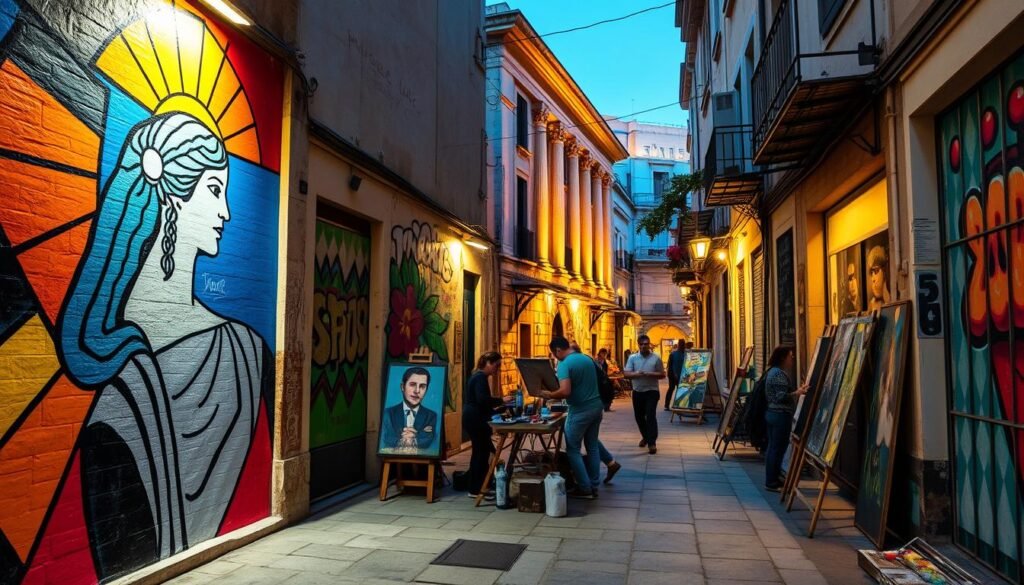
Evenings here pulse with color and film, where walls and screens rewrite the city’s mood. I let a short walk link bold murals and an outdoor movie for a single, memorable night.
Why I book a guided walk
I book a tour to learn the names behind the work—INO and Achilles, for example—and the political roots from the 2010s crisis. Guides explain eras, neighborhoods, and why certain pieces matter.
Thision Open Air Cinema
After my walk I head to Thision Open Air Cinema. Films run in the original language with Greek subtitles and the Acropolis glows behind the screen.
- I arrive early, grab a seat, and pick up popcorn or a cold beer.
- I often revisit favorite murals alone and photograph them in soft light.
- I keep routes simple and stick to well-lit streets when I’m out late.
“Street art and cinema gave me culture beyond museums; the whole city felt like the venue.”
Neighborhoods I Never Skip: Plaka, Anafiotika, Psirri, Monastiraki, and Exarchia

I wander these neighborhoods when I want a mix of history, coffee, and honest local life. Each block offers a different mood, so I pick one or two areas per outing and move slowly.
Plaka has narrow streets lined with tavernas and photo-ready corners like the Mnisikleous Street Stairs. I climb those steps for meze and a lively dinner scene carved into stone.
Anafiotika feels like an island tucked under the rock. Its whitewashed lanes, blue doors, and bougainvillea make it a quiet place for early photos.You can learn more about things-to-do-in-mexico-city
Psirri, Monastiraki, and Exarchia
Psirri hums with bars and coffee spots; I linger there without a plan and soak up the creative energy.
Monastiraki peaks on Sundays at Abyssinia Square, where I browse the flea market and hunt small shops for vintage finds.
Exarchia mixes cafés, boutiques, and bold street art. On weekdays it feels most alive and local.
- I mix strolling, snacking, and shopping so each walk stays relaxed.
- You’ll find artisan studios, tiny shops, and hidden courtyards that reward wandering.
- I keep cash handy for market vendors and small cafés.
| Neighborhood | Highlight | Best Time | Tip |
|---|---|---|---|
| Plaka | Mnisikleous Street Stairs, tavernas | Morning or dusk | Go early for photos; dine on the steps |
| Anafiotika | Cycladic lanes, blue doors | Early morning | Wear comfy shoes; streets are narrow |
| Psirri | Cafés, bars, creative spaces | Afternoon to late night | Try local coffee and linger |
| Monastiraki | Flea market at Abyssinia Square | Sunday mornings | Bring cash for bargains |
| Exarchia | Street art, indie boutiques | Weekdays | Explore side streets for murals |
Markets, Meze, and Late Nights: How I Eat and Drink My Way Around the City

I plan my food routes around market rhythms, rooftop reservations, and late-night meze stops. I start at Varvakeios Market (since 1884) to watch fishmongers call the catch and grab olives and fruit for later.
On Saturdays I wander Kallidromiou Farmers’ Market in Exarchia for honey, herbs, and people-watching with a coffee. After a market loop, a quick lunch at The Black Salami Microbakery or a wrap from Falafellas keeps me moving.
Wine, meze, and views
Early evening I slide into Cinque Wine Bar in Psirri for a tasting—friendly staff, Greek varietals, and a tidy cheese board. Later I pick a rooftop terrace or a tucked Plaka taverna for dinner; the restaurants here pair simple cooking with classic views.You can learn more about things-to-do-in-lisbon
- I’ll find specialty shops and delis like ERGON for edible souvenirs and easy breakfasts.
- I keep nights flexible: sometimes I linger over meze, other times I graze from market to bar to gelato.
- For groups I order a lot of small plates so everyone tastes widely without committing to one main course.
“This city rewards curiosity with flavor; leave room in your schedule and appetite for surprises.”
Family-Friendly Athens: Teens, Short Attention Spans, and Smart Ruin-Hopping
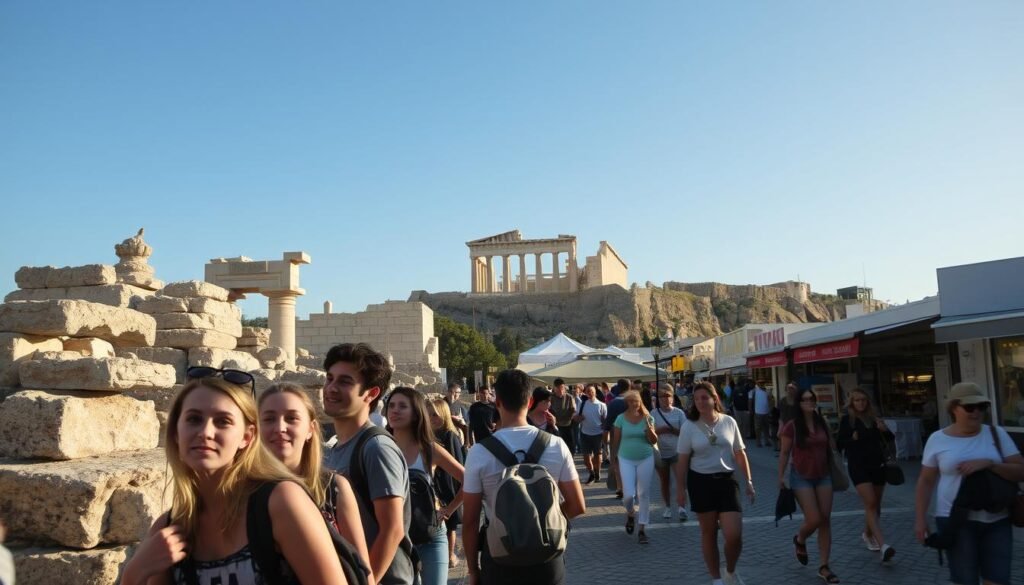
My family-friendly rhythm mixes quick museum hits, evening tours, and beach breaks for balance. I plan around short, clear wins so the day feels fun rather than forced. Even a single rooftop view or gelato counts as progress.
Guided tour tips and evening visits
I book an evening Acropolis tour after 5 p.m. when heat and crowds drop. That time often leaves us wandering Dionysiou Areopagitou into Plaka for dinner and street music.
Mixing history with play
I cap each ruins session at a comfortable chunk and alternate with markets, gardens, or a sweet stop. Herakleidon Museum is a hit—gadgets, automata, and the Antikythera Mechanism make ancient tech click for curious people.
Beach breaks and lake detours
On hot afternoons I swap a site for a half-day at a coast beach or Lake Vouliagmeni. Warm water and facilities mean we return refreshed and ready for evening plans.
- Keep snacks and water and a flexible plan so you can pivot fast.
- Pick guides who tell stories, not dates, and let teens pick one neighborhood choice for buy-in.
“Small wins—rooftop views and open-air film nights—turn a good day into a great one.”
My Favorite Day Trip: Temple of Poseidon at Cape Sounion for a Sunset You’ll Remember
A short drive south of the city, Cape Sounion feels like a natural stage for a dramatic sunset. The Temple of Poseidon sits on a cliff above the Aegean, and the view here really rewards a modest outing.
I usually allow 90–120 minutes each way, depending on traffic. Driving gives me the freedom to linger through the final minutes of light—many organized tours leave before the very last glow.
On full days I combine Sounion with a swim at a nearby coastal beach or a warm dip at Lake Vouliagmeni. The lake often reaches about 80–85°F in summer and has a café and facilities, which makes the trip relaxed and simple.You can learn more about things-to-do-in-oahu
Driving, guided options, and a practical evening plan
I arrive early enough to explore the site before sunset and bring a light jacket for the cooling breeze. If I don’t want to drive, I book a small-group tour that returns later so I still see the finale.
- I plan Sounion for sunset—the columns glow as the sky shifts from gold to violet.
- I give myself up to two hours out of the city and often less on the return leg.
- I pack water, snacks, sunscreen, and a camera, though sometimes I put the camera down and just breathe it in.
“It’s the easiest big ‘wow’ outside the center, and well worth the trip.”
Back in the city, a slow walk or a gelato makes the perfect coda to the day. This place remains my favorite simple escape for a memorable evening by the sea.
Getting Around, Tickets, and Timing: Practical Tips That Save Time and Steps
A few practical transport habits keep my days efficient and my feet happy. I start with simple choices that shave minutes off lines and make each hour feel fuller.
Airport, metro, and walking the center
From the airport I ride Metro Line 3 into town. Trains run roughly every 30 minutes and the trip to central stops takes just over half an hour. It’s a predictable way to begin a visit athens day.
I walk most of the center and only use the metro when distances stretch or my feet need a break. For longer hops I buy a city transport pass, but I always budget for a separate airport ticket.
Tickets, passes, and seasonal pricing
I rely on the Combined Ticket when I plan multiple sites. It covers the major archaeological locations across five days so I can space visits without rushing.
Keep an eye on museum pricing—summer often costs more than winter. That small timing choice can save money and time.
Best times, timing my visits, and smart habits
I aim for morning entries at big sites and keep a late-entry option in my back pocket. Spring and fall bring kinder temps and fewer crowds, so pacing feels easy and pleasant.
- Quick wins: check opening hours and last-entry times before you leave the hotel.
- Hydration: carry a refillable bottle and use fountains and cafés.
- Navigation: download offline maps so wayfinding stays smooth underground and above.
“A little planning up front saves countless minutes during the day.”
Where I Stay: Central Neighborhoods, Boutique Hotels, and Rooftops with a View
Finding the right hotel changed how I experienced the city each evening. I pick a base by vibe, then check practical things like walking distance to sights and transit.
Psirri, Kolonaki, Syntagma: matching areas to your vibe
Psirri gave me a buzzy, creative energy with trendy bars and cafés just off the main squares.
Kolonaki felt polished and calm—perfect when I wanted quieter mornings and boutique shopping.
Syntagma sits at the practical center; if my visit was short, I favored its easy hops to major sights.
Stays I like: Monument, Monsieur Didot, and ERGON House
Monument sits in a restored 19th-century Ernst Ziller building in Psirri. The hotel mixes historic character with modern calm and has reservable private wellness like a sauna and hammam.
Monsieur Didot is a neoclassical townhouse in Kolonaki with six unique rooms. High ceilings and in-room breakfast made me slow down and savor mornings.
ERGON House near Syntagma offered a minimalist room above a lively food hall. I booked it for the simple rooms, a nice rooftop when open, and direct Acropolis view at dawn.
- I choose addresses that make walking easy, with cafés, shops, and restaurants outside the door.
- For short visits I pick Syntagma; for longer stays I split nights across two areas.
- I always check for a rooftop or balcony—one small view changes how I end the day.
- Book boutique rooms early; the best ones run out fast.
| Hotel | Neighborhood | Key perk | Best for |
|---|---|---|---|
| Monument | Psirri | Private wellness (sauna/hammam) | Design lovers, nightlife |
| Monsieur Didot | Kolonaki | Townhouse charm, in-room breakfast | Slow mornings, polished stays |
| ERGON House | Syntagma | Food hall below; Acropolis view | Central convenience, culinary fans |
“A good base makes wandering feel effortless and evenings feel at home.”
Conclusion
You’ll get the most from this city when you slow down and pick a clear rhythm.
I framed my days around one big historic site, then filled the edges with markets, food, and rooftops. Pair the Acropolis Museum and the rock for context, then use a Combined ticket to space visits like the Roman Agora and Hadrian’s Library over a few relaxed days.
Watch the guards at Syntagma Square, reset in the National Garden, and plan one memorable trip to Cape Sounion at sunset. Pick a hotel that matches your vibe—Psirri, Kolonaki, or near Syntagma—and you’ll find the city easy to love.
For a quick refresher and practical options, see this concise things athens guide and make the trip your own.


